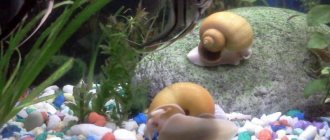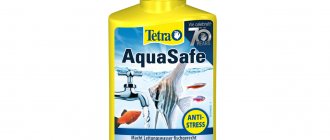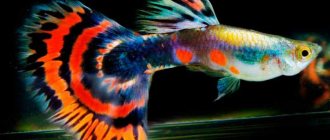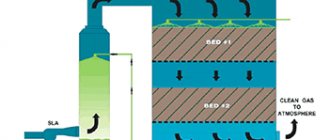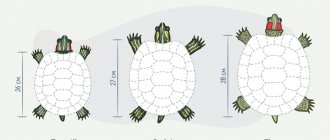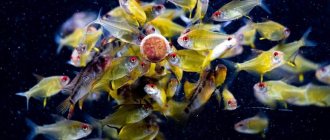5
(8)
Before starting an aquarium, the breeder must learn all the intricacies of this process. In particular, how to make the aquatic environment suitable for comfortable keeping of fish, and how to maintain it in this condition further. Any aquarium pet is incredibly sensitive to the chemical composition of the water. For this reason, you need to carefully monitor its parameters using special tests.
What is it, why is it done?
Tests allow you to find out the most important parameters of aquarium water, on which the life of aquatic organisms and the healthy growth of plants depend. Tests also allow you to determine the presence of toxic chlorine, ammonia, ammonium and nitrites in water, which often cause the death of fish and shrimp.
On sale you can find tests for:
- Acidity (pH).
- Carbonate hardness (KH).
- General hardness (GH).
- Nitrates (NO3).
- Phosphates (PO4).
- Nitrites (NO2).
- Ammonia/ammonium (NH4/NH3).
- Oxygen (O2).
- Carbon dioxide (CO2).
- Copper (Cu).
- Iron (Fe).
- Silicates (Si).
- Chlorine (Cl).
- Calcium (Ca).
- Magnesium (Mg).
It is not at all necessary to have a complete set of all tests; each of them is useful in specific situations. Tests are carried out to make sure that everything is in order with the water in the aquarium, to calculate the dose of fertilizers applied, and to identify the cause of the problems.
Why are tests needed for an aquarium?
Most aquarium fish diseases occur due to poor quality water. Due to the fact that animals must constantly resist the toxic effects of nitrates, nitrites and ammonia, their bodies weaken and become vulnerable. Diseases that cannot be cured begin to actively develop, since in a poor environment the fish will get sick again. To get rid of this cycle, you must first reduce the concentration of toxins in the water. To understand what to focus on - the disposal of ammonia, nitrites, nitrates, chlorine, hardness or acidity, etc., it is necessary to conduct tests for the aquarium.
Main types
There are different types of tests available on the market, each of which has its own strengths and weaknesses.
Stripes
They are litmus paper, which upon contact with water changes color depending on the presence and quantity of certain substances.
Advantages:
Ease of use. It is enough to immerse such a strip in the aquarium for a few seconds and you can immediately see the result.- There are multi-test strips. Using one such test strip, you can find out several important parameters at once.
- There are automated strips. Some manufacturers of such tests develop applications for smartphones, with which you can point a camera at the used strip, and it will show the result.
Flaws:
- Low accuracy. The stripes only allow you to approximately find out the parameters of interest.
- Some parameters cannot be determined by such tests.
- Short shelf life.
Drip
The most popular and one of the most accurate tests.
Advantages:
- high accuracy;
- there are tests for almost all important parameters;
- the opportunity to buy an entire mini-laboratory.
Flaws:
- Carrying out tests takes a lot of time;
- some manufacturers offer low quality products;
- high cost of good tests;
- most often a large step in nitrate/phosphate tests.
Electronic
Electronic tests include a pH meter and a TDS meter. They are actively used by aquarists.
Advantages:
- Doesn't take much time.
- Has no expiration dates.
- It doesn't end.
- High accuracy of results.
Flaws:
- Special storage conditions are required.
- Requires regular calibrations.
- Calibration solutions are quite difficult to find commercially.
- The TDS meter is applicable only at the water treatment stage, as a test for aquarium water - it is useless.
- High price.
Other
There are also tests that run continuously. These are tests to determine the carbon dioxide content in water. The test consists of a glass flask (drop checker) into which a special liquid is poured. Depending on the color the liquid takes, one can judge the concentration of CO2.
The advantage of a long-term test is that it shows the result constantly, the disadvantage is that what it shows is the result of two to three hours ago, that is, the test works with a slight time delay.
pH test (acidity)
Despite the fact that this is the simplest aquarium test
, it is the value of water acidity (pH) that has the most significant impact on the processes associated with plant growth in the aquarium. Whatever the values of nitrates or phosphates in your planted aquarium, if the pH tends to 8, you will not see good growth and appearance of most plants. This is a very common problem, especially in hard water. You can read more about the availability of plant nutrients depending on pH in the article about Diseases of aquarium plants. This is enough to classify this aquarium test as a “must have”.
How do you know which kits are needed?
Each situation or problem requires its own set of tests:
| Test | For what | |
| When starting the aquarium | KN | Allows you to find out whether the quality of tap water is suitable for the aquarium plants and fish you want to have. |
| NH3/NH4 and NO2 | Determines the maturation of the nitrogen cycle. The aquarium can be populated only when the values of these parameters reach zero. | |
| Creating a Planted Aquarium | NO3, PO4 | These parameters should be used as a starting point when applying fertilizers. Optimal values for NO3 – 15 mg/l, PO4 – 1 mg/l. An excess or deficiency of one of these parameters provokes the appearance of unwanted algae. |
| CO2 | Controlling the carbon dioxide content is very important, since the task is to feed the plants with carbon dioxide without harming the fish. | |
| KH | It is very difficult to establish the required level of carbonate hardness without a KH test. | |
| pH | Knowing the pH and KH, you can determine the CO2 level. | |
| Mass mortality of fish for unknown reasons | NH3/NH4 NO2 Cl | It is important to determine the presence of poisons in aquarium water: either it is a jump in nitrogen compounds, or the harmful effects of chlorine. Further actions depend on the presence of certain substances. |
| The appearance of algae fouling | PO4 NO3 | Understand which element is too much and which is missing. Using substitutions and monosolutions, level these parameters to optimal levels. |
| Maintenance of a marine aquarium | Ca Mg | Determine the salt composition of the water after preparation, and, if necessary, adjust it. |
| Si | Make sure there are no silicates. | |
| Keeping decorative shrimp | G.H. | For proper remineralization of water. |
GH test (general hardness)
For a planted aquarium, testing total water hardness is not as important as testing carbonate hardness and pH. As is correct, the total hardness is several degrees higher than the carbonate hardness and it does not affect the pH values. But there are rare cases when carbonate hardness is higher than the general one. This happens when carbonate hardness is caused by high levels of sodium and potassium carbonates in the water. It is in this case that it is most correct to say alkalinity, rather than carbonate hardness. It is very difficult to keep aquarium plants in such water. Therefore, in practice, the GH test is only needed to determine whether the total hardness in water is too low compared to carbonate water.
When are they needed and when are they not?
In a good way, a basic set of tests is always needed, since problems tend to appear suddenly.
The basic set is considered to be tests for KH, pH, GH, PO4, NO3 . Other tests can be purchased as needed.
Proper starting of an aquarium is starting with the help of tests; specialists never release fish without checking the water for the presence of toxic substances. This is especially important when the fish is capricious and expensive.
It is very difficult to successfully maintain a planted (Dutch) aquarium without tests for nitrates/phosphates, because resetting one of these parameters and deviating too much from the norm will turn a beautiful underwater garden into a swamp with blooming water in a few weeks.
Ammonia/ammonium test (NH3/NH4+)
The ammonium test is even more unstable than the nitrate test, and without calibration with a standard ammonium solution there is no point in using it at all. No matter what manufacturers tested for ammonium I came across, all of them, after calibration, were corrected not just by plus or minus 50%, but literally by several times in the direction of underestimating the actual indicators. Even in the first half of their expiration dates. If we talk about the use of this test in plant aquariums, then its use (of course, with preliminary calibration) makes sense only if you add large doses of ammonium salts as plant nutrition. After all, ammonium and especially ammonia are very toxic to living organisms, even in low concentrations.
How to choose the right one correctly?
You can find products on sale in different price categories . But you shouldn’t trust the cheapest tests; they have one big drawback - a very vague scale.
For example, a nitrate test can only show 4 options - 0 mg/l, 30 mg/l, 50 mg/l and 100 mg/l. But such precision is not enough. Therefore, when purchasing, you can ask for a box and see what step this test involves. The smaller it is, the better.
Also, some tests have another drawback - it often happens that if it is necessary to compare the color of the tested water with a color scale, this cannot be done. There is simply no such color on the scale.
It is better to trust trusted manufacturers who have long proven themselves in the market - Tetra, JBL, Sera.
Tetra Water Test Set
A small laboratory for analyzing aquarium water, contains tests for KH, pH, GH, NO2 and CO2. The tests are accurate and convenient.
The kit includes:
- syringe and cuvette,
- reagents,
- test tubes and instructions in Russian.
Also in the kit you can find a table of optimal water parameters and recommendations on what to do if the test results are unsatisfactory. The cost is about 3400 rubles.
Sera Quick test
One of the best test strips that allows you to quickly determine the most important parameters:
- general hardness
- carbonate hardness,
- acidity,
- nitrates and nitrites.
To carry out the test, the aquarist simply needs to place the strip in the aquarium for 1 minute, and then compare the result with a color scale. The kit includes 20 strips and a color chart. Cost - 900 rubles.
JBL ProAquaTest
Professional laboratory for testing. Allows you to measure the following parameters using the drop method: pH, KH, CO2, NO3, PO4, Si, K, Mg, Fe.
The kit includes:
- 22 reagents,
- 2 syringes,
- 2 test tubes,
- notepad for recording the results,
- instructions,
- pen,
- thermometer,
- measuring spoons.
JBL tests are recognized by aquarists as the most accurate; despite such an impressive cost, they remain popular. This set will be especially useful for lovers of planted aquariums.
Cost - 9000 rubles.
Iron (Fe) test
Regarding myths about the suitability of some aquarium tests
For plant aquariums, the speech of JBL representative Heiko Blessin at a seminar for pet store sellers was very revealing for me.
He told the story that once upon a time no one bought their iron test. Then they decided to tell customers that the iron test is a fertilizer test. As a demonstration, it was proposed to drop fertilizer into a test tube, after which the test showed a very bright color of the test solution. And after this, sales of this test increased significantly. This is how myths are born among aquarists. In fact, the iron test
is completely unsuitable as a tool for determining the amount of nutrients in water for plants. In fertilizers, iron is partially or completely bound with strong chelates, which do not allow the drop test to correctly determine the iron concentration in an aquarium, but ensure the availability of iron for plants in the aquarium. And the iron in tap water, which can be determined by the test, is available to plants in very limited quantities due to rapid sedimentation. With this test, you can only determine whether or not there is iron in the water, as in the case of the experiment with fertilizers above. This test does not allow us to understand how much iron is available and how much it is available to plants.
How to use?
Instructions:
- Simply dip the strips Then compare the color of the strip and the color scale that came with the kit.
- Drip test:
- pH – take 5 ml of aquarium water into a test tube and add 5 drops of test liquid, shake and compare the color of the water in the test tube with the scale;
- KN - take 5 ml of aquarium water into a test tube and add 1 drop of test liquid, shaking the test tube each time, as soon as the color of the water in the test tube changes - stop adding test, the number of drops added is equal to the level of carbonate hardness. 1 drop = 1°KN;
- GH – same as KN;
- the rest of the drop tests are two-component and involve the addition of 2 reagents; each manufacturer offers its own testing method, which can be found in the instructions.
- Electronic . Take some aquarium water into a small container and place the device there. Turn it on. At least once a week, an electronic pH meter needs to be calibrated with special solutions. It is better to calibrate using two points.
Long-term CO2 test .
Pour indicator liquid into the drop checker and attach it to the aquarium using a suction cup. A drop checker is only necessary if carbon dioxide is supplied to the aquarium. In the case of alternative methods of carbon introduction (liquid, tableted), it is not effective.The color that the liquid takes indicates the gas content in the water:
- yellow – excessive quantity;
green – optimal;
- blue – lack of CO2.
The operating principle of the drop checker, its description and use are in the video:
What to do after diagnosis
Once the test is used and the result is negative, immediate action should be taken. If the result obtained does not deviate greatly from the norm, you must perform the following steps:
- leave purified water so that all harmful substances settle;
- partially remove contaminated water from the aquarium and add clean water;
- carry out the procedure until the indicators return to normal.
If urgent action is required, the following actions are recommended:
- carefully move the fish and other aquatic inhabitants to another container;
- drain the water and disinfect the container and decorative items;
- Purify the water using a filter and heat it to the desired temperature;
- carry out aeration and, if necessary, increase acidity;
- pour out the liquid and gradually return the fish to the aquarium.
If it is impossible to move the fish into a new container, you can purchase a solution in specialized stores. It is added to purified water or added to the aquarium. The action of such solutions is aimed at eliminating the pathogenic area and normalizing the pH level.
What is the price and where to buy?
Aquarium tests are easy to find for sale in pet stores, aqua salons and aqua galleries. You can also always order them in the online store and pick them up at the nearest post office. The cost of tests depends on its type, the parameter being studied and the manufacturer.
Below are approximate prices for the most popular tests:
| JBL | Sera | Ptero | Tetra | |
| pH | 800 rub. | 500 rub. | 300 rub. | 500 rub. |
| KH | 600 rub. | 400 rub. | 250 rub. | 450 rub. |
| G.H. | 700 rub. | 400 rub. | 250 rub. | 450 rub. |
| NO3 | 1500 rub. | 800 rub. | 500 rub. | 1000 rub. |
| PO4 | 1200 rub. | 800 rub. | 600 rub. | 1400 rub. |
| NH3/NH4 | 1300 rub. | 800 rub. | 500 rub. | 1000 rub. |
All prices are approximate, taken from online stores and rounded to the nearest 50 rubles. according to a mathematical principle.
What do the tests check?
There are various tests to check water for:
- Rigidity. This indicator of water depends on the presence of calcium and magnesium salts in it. The concept of total water hardness includes an indicator of variable and constant hardness. Most often, to assess the state of the environment, the last indicator is needed, because it is this indicator that affects the life activity of aquatic inhabitants. The norm is 5-20 °C.
- Ammonia content. This element is a product of the vital activity of water inhabitants. It is easily soluble and can cause respiratory problems in fish due to its high toxicity. This indicator for tests should be equal to zero.
- Acidity. This indicator should be within 6-8 pH, that is, the environment should be non-acidic. Please note that aquarium soil and other decorations can change the pH of the aquatic environment, so constant monitoring and adjustment is needed.
- Ammonium content. It is a product of the reaction of ammonia with water. It is not as toxic as ammonia, but can also be dangerous.
- Amount of nitrites and nitrates. These elements are obtained due to the oxidation of ammonium substances. The maximum permissible content of these substances is 30 mg/l.
The value of these indicators will be higher if the functioning of the biological filter of the environment is disrupted. The concentration of ammonium and ammonia substances is directly related to the acidity of the aquatic environment. To maintain the normal concentration of all substances, it is necessary to regularly clean the aquarium and change the water in it.
What kind of water should I put in the aquarium? - Answer
You have probably already heard or read that an aquarist (not only an experienced professional, but also - especially! - an aquarium owner) in order to competently and successfully organize an aquarium, needs to know the exact values of some physical and chemical parameters of aquarium water.
Moreover, not only aquarium water, but also tap water, well or other water (some novice aquarists use bottled drinking water purchased in a store to replace).
The life and health of your pets, the general condition of the aquarium and your peace of mind and joy depend on the quality of water.
If you want an aquarium without problems, learn to understand the quality of aquarium water.
Experienced aquarists “see” and “feel” the aquarium; they use tests mainly to check their assumptions. We, water teapots, have to learn this.
Since you don’t have experience yet (otherwise you wouldn’t be reading these lines), you need to acquire it. Tests for aquarium water help a novice aquarist with this.
WHAT TESTS SHOULD I BUY?
The minimum set of required tests: Ph, Gh, ammonia/ammonium, nitrites and nitrates.
Why you need to know the value of Ph was written long before me , I will not repeat it.
It is best to buy drop tests. They are easy to use, inexpensive, economical and quite accurate. NILPA drop tests have proven themselves well. I still use them now, along with Aquayer drop tests, which I like better, but are a little more expensive.
There are large sets of tests on sale, but these are for “gardeners” and professionals; you can, of course, buy these if you want to play around with water testing “like an adult.”
For a beginner, 8 tests: those listed above plus carbonate hardness and the potassium permanganate test (about it at the very end of the article) are more than enough. Our task - to keep at least these parameters under control - is not so simple.
I haven’t tried test strips: according to reviews from experienced aquarists, drop tests are better. You can check and compare.
There is plenty to choose from, decide what you like best.
Buying tests is not a problem now, even if you live in the outback where there are no aquarium stores. Order, for example, from Living Water or AkvaPiter and receive it by mail.
Whatever tests you choose, each package contains detailed instructions and color tables for comparing and evaluating the results obtained. Even a second grader can figure it out.
Tests are needed, don’t skimp on them - you’ll spend much more on medicines and new fish.
As a last resort, start with Ph and Gh (about 200 rubles), after 7 - 14 days you will need ammonia/ammonium, after another week - nitrites and nitrates. Kh - optional, but may be useful if you plan to keep shrimp.
This is if you don’t have an aquarium yet.
If you already have an aquarium full of fish, but don't have an experienced aquarist nearby to guide you, you need all the tests, fast.
*************************************
WHEN SHOULD YOU START TESTING THE WATER?
Ideally, before you even buy an aquarium.
Because until the water kettle gains experience and knowledge in practice, it is very difficult for him to change the acidity or hardness of the water, and even more so to maintain constant values of these parameters.
For fish, stability, a stable balance of the biological and chemical environment in which they live, is of decisive importance.
The most severe conditions - acidosis and alkalosis - threaten absolutely healthy fish when the general acidity of aquarium water changes.
Therefore, it is best for beginning aquarists to choose their first pets from those fish species that are suitable for the parameters of the tap water used in the aquarium.
Bottled water is not the best option , as its mineral composition can adversely affect the health of aquatic organisms. Even if you manage to find the right water for your aquarium needs in a store, the well-being of your aquarium will continue to depend on the availability of “that same” water on sale. In addition, it is unreasonably expensive.
I myself do not use bottled water, but I have repeatedly read on forums that you can use Shishkin Les drinking water if necessary (maybe it will come in handy for someone).
check the quality of tap water (hardness, acidity, mineral composition, presence of harmful impurities, chlorine, bacteria) in the laboratory. I haven’t done this myself, I think most of you can do the same on your own and with drop tests. To begin with, we will have enough NILPA tests for Ph and Gh.
Ph is the active reaction (acidity) of water. I have water flowing from my water supply with a Ph of about 6. The total water hardness Gh is about 3, the carbonate hardness Kh is less than 2. These water parameters are well suited for guppies, various catfish and many other fish.
I wanted to get a platie, but they don’t like soft water. I raised the overall hardness (up to 8 - 10 units) by adding the calculated amount of solutions (ampoules, for injection) of calcium chloride and magnesium sulfate. As a former physician, this was not difficult for me to do. At first it was even interesting.
In fact, this is quite troublesome, because you need to constantly monitor and maintain the set values: the water in the aquarium evaporates, a certain amount of mineral salts precipitates in the form of insoluble precipitation, etc.
An aquarium is a complex living organism, interference in the life of which is not always predictable. As a rule, the less intervention, the easier, calmer and more enjoyable aquarium life. — With proper organization, of course. Therefore, it is better to start “dancing” from what we have initially.
Although I have the impudence to experiment (usually after thorough theoretical preparation and no less thorough thinking), now I choose fish and shrimp based on the existing conditions, the relative stability of which ( homeostasis ) I can maintain in my aquariums without any tricks .
Quite quickly, I abandoned chemistry in favor of natural methods (trying the addition of tuff, marble and coral chips). Naturally, I didn’t come up with this idea myself: smart people suggested it.
By the way, when the general hardness (and salt composition of water) changes, the acidity naturally and inevitably changes. Increased to 7.2. These parameters: Ph - 7.2; Gh - 8 - 10 and Kh - 3 suit me completely because they are suitable for all my pets.
I increased the carbonate hardness and (at the same time) the buffering properties of water with the help of tuff, on the advice of experienced aquarists. Not much, up to 3 units - the minimum at which ampullaria and other mollusks feel normal, and shrimp molt without problems.
The issue of carbonate “rose” with the purchase of shrimp. That’s when I consistently experimented with marble, coral chips and tuff.
Tuff suits me completely. In addition, it looks beautiful in the aquarium and serves as an excellent refuge for shrimp fry.
*************************************
SO, WE KNOW THE PARAMETERS OF TAP WATER
We bought and launched an aquarium, waited for it to “mature” (the water went from cloudy to perfectly clear) and are about to launch the first fish.
This is where we need tests again. To begin with, only Ph and Gh. For what? — Yes, because in the aquarium we have soil, driftwood, stones and decorations, and we cannot be absolutely sure that the parameters of the tap water poured into the aquarium have not changed.
I already mentioned above that changing one parameter entails changing another. In addition, the acidity values of aquarium water can change abruptly during the day. This depends on the number of living plants in the aquarium, on aeration, on the species and quantitative composition of the aquarium population.
Therefore, we test the water for Ph again. We make sure that everything is in order, you can launch the fish. It also happens that some snag or stone (or soil, or decoration - anything can happen) causes a strong shift in pH to the acidic or alkaline side. In such cases, it is necessary (by the method of elimination) to identify the cause of unwanted changes and eliminate it. Read the article about mistakes made by beginner aquarists , error No. 17.
*************************************
FISHES PURCHASED
They were delivered home in tanks with aquarium water in which they “lived” before. If you bought young fish from a breeder, it would be a good idea to find out in what water they were born and raised. If the parameters of this water differ significantly from yours, quickly transferring the fish to new water (in your aquarium) can undermine their health for a long time or even cause sudden death from shock.
The same can be said about store-bought fish, but with the adjustment that they may have recently been transferred from one water to another several times, and they are more weakened and susceptible to stress and its consequences.
Therefore, we test the water in which the fish arrived and draw conclusions for ourselves whether they can be adapted to new water in 20 - 30 minutes (quickly) or whether it will take several hours to transfer them from one water to another, which requires more attention and care.
By the way, snails, shrimp and aquarium plants also require adaptation to new water, otherwise they may get sick.
Shrimp are especially sensitive to the slightest changes in water parameters. Therefore, even “unkillable” cherry shrimp should not be planted in an aquarium running on tap water before 2-3 months.
For some time I lived with Christmas shrimp, for the well-being of which I had to establish a constant drip water change. For a long time, all my aquariums were open, and neither fish, nor snails, nor shrimps ever made an attempt to escape.
**************
THE FISH HAS SUCCESSFULLY MOVED TO A NEW PLACE
They behave as healthy fish of the corresponding species should behave (for comparison, watch the video on YouTube). We are glad that the first test was successful. But it’s too early to calm down.
The fact is that the biological system of a “young” aquarium has just begun to form. Yes, beneficial nitrifying bacteria have already settled in the water, but there are still very few of them, because before the appearance of fish, the nutrition of these bacteria was very poor.
Only now, when the fish begin to breathe, eat and poop, will the bacteria have a lot of food. At first (since there are still few bacteria), they will not cope with their task - purifying water. The filter has also not yet begun to work at full capacity; this takes time.
Therefore, in any case, the acidity of the water will change throughout the day, and within a few days its value may change for the worse, most often decreasing. This is dangerous for fish. (Rigidity is not particularly interesting to us now; it is more or less constant).
The water is still clear, the fish look and behave normally, but a caring owner will check the water for Ph and ammonia/ammonium the very next day. Ammonia poisoning is the main danger for residents of a new aquarium .
Ammonia appears in water as a result of physiological secretions of aquatic organisms and the decomposition of food residues and rotted plant leaves. Since it is not immediately possible to select the optimal dosage of food, and many novice aquarists tend to overfeed the fish, the situation with the quality of aquarium water, which was previously favorable, can sharply worsen.
For some time, water, using its own biological resources, is able to fight excess organic pollutants, so deterioration does not occur immediately . For the time being, ammonia and other transparent poisons accumulate in the water, and the inexperienced and illiterate aquarist suspects nothing of the impending environmental disaster.
Then the concentration of toxic substances in the water reaches a maximum value. As a rule, this happens simultaneously with a decrease in the Ph value to unacceptably low (5 or less), which is doubly dangerous. At this stage, the owner of the “victim” aquarium sees, without any tests, that things have “suddenly” become rubbish.
The water may become cloudy or green ( or may still remain clear ), but the fish seem to begin to “sick”: they become dull, sad, eat poorly or refuse food altogether, move little, lie on the bottom or gasp for air at the surface, itch scenery or trying to jump out of the water.
Any medications or chemicals added to bad water will only make the situation worse.
To prevent a similar thing from happening to you and your aquarium, “keep an eye” on the condition of the water using tests. Ph, ammonia/ammonium, and after a week (better, of course, right away) these tests will be supplemented by monitoring the content of nitrites and nitrates ( slow-acting poisons, due to the gradual poisoning of which fish become susceptible to any diseases and become easy prey for parasites ).
In the first weeks of a new aquarium’s life, do tests at least every other day, and if you have a lot of fish, do tests every day, until the biological balance is established tell you about the arrival of this happy moment ).
*************************************
SO, THE AQUARIUM IS “STILLED”
The biological system successfully copes with a regular load, Ph has a given value, stable, ammonia/ammonium is zero, nitrites are the minimum permissible concentration or absent, nitrates are an insignificant amount.
It seems like we can calm down. Indeed, now we will need the tests that we used almost every day and which we mastered with a solid “A”, less often, about once a week . Provided that the general condition of the aquarium, the appearance and behavior of the fish are normal.
However, the Ph value, which is stable during the day, can change significantly at night , especially if the water in the aquarium is soft (Gh less than 5) and there is no or insufficient aeration. There is little good in this. Therefore, if “against the background of complete well-being” you “don’t like” something in your aquarium, measure the Ph values several times during the day: in the morning, at 7 o’clock, in the afternoon, in the evening and at night, at 2 - 3 o’clock.
It may turn out that your instincts did not let you down, and you need to take measures to stabilize the Ph: for example, add a piece of tuff to the aquarium to improve the buffering properties of water or a special conditioner, for example, Tetra Aqua Easy Balance. (Small daily “fluctuations” in Ph—within 0.5 units—are normal.)
Tests will help you determine when and how much water needs to be changed in your aquarium.
*************************************
WE HAVE ALREADY LEARNED SOMETHING
During the period of active water research, we learned to pay attention to many seemingly insignificant, but very important aquarium “little things”: the smell, color and transparency of the water, the condition of the surface (is there a film), glass (bacterial and algae deposits), appearance and behavior fish and snails.
We began to notice the slightest changes and have already learned to draw some useful conclusions, supported by the results of water testing and personal observations (because no two aquariums are the same).
Little by little we are becoming experienced and sensitive aquarists. We begin to understand when to be wary and when to remain calm. How much feed does our population need daily? How often is it necessary to change the water in our aquarium? Are filtration and aeration effective enough? Water testing also helps with this.
If by this time (2 weeks after establishing biological equilibrium in the aquarium) we decide to purchase new fish, we will already have some idea of the additional load on the system and will be able to approximately calculate how many and what kind of fish can be added to the aquarium at the moment. And even what kind of population the biosystem of our aquarium can serve in the future.
Here it is: informed planning, supported by the results of observations and research. Here it is, much-needed experience - the key to self-confidence and order in the aquarium.
Naturally, adapting new fish to the conditions of your aquarium is no longer a problem for you.
There is a very high probability that you, like me, will be able to avoid serious mistakes and their consequences, calls to forums asking for urgent help, deaths and disappointments from the very beginning.
What I sincerely wish for you. And this does not require either “academic” knowledge or “heroic” efforts. Just take care of the urgent elimination of illiteracy and listen to my advice and the advice of those from whom I studied (following the links).
*************************************
ADDITIONAL SKILL YOU WILL NEED
In the photo on the right you can see the results of the potassium permanganate test (water taken from my aquariums).
K - control sample of solution (tap water), 1 - water from a 30 liter aquarium, 2 - from a 100 liter aquarium.
The test shows that the water in both aquariums at the time of testing is quite suitable for the life of aquatic organisms.
In the bottom photo, the test result is not so favorable (the table for analysis was taken from the article by V. Kovalev, the link to which is given above). In this aquarium you need to clean the soil and do a water change. Without delay!
************* For beginners, these 8 basic tests are quite enough, believe me
Then you yourself will determine the path of your development and, perhaps, after a while you will make good progress in the study of aquarium water.
Now, having read to the end, you can decide for yourself whether you need tests for aquarium water or whether you will try to act at random (with all the ensuing consequences).
Experienced aquarists, as a rule, rarely use tests. That's what experience is for. However, as far as I know, many experienced aquarists have both tests and an “aquarium first aid kit” at home. Me too, from the very beginning. But no one got sick!
By the way, on the forums one of the first questions to you will be “water parameters in your aquarium.”
Without knowing the pH and other results of testing aquarium water, no fish doctor can help you. Good luck to you and prosperity to your aquariums!
Types of tests for aquarium water
Aquarium tests come in strip, drop and electronic forms.
The simplest and cheapest are test strips. With their help, you can control the main parameters: GH (total hardness), pH (acidity), nitrite, nitrate and chlorine content.
Drop tests are more accurate. They are easy to use, fairly inexpensive and have a wider range of controllable parameters.
They can be purchased either as a set or for individual parameters. Most aquarists prefer drop tests.
Electronic testing devices are used when it is necessary to monitor the condition of water over a long period of time.
The simplest and most inexpensive among them is a tester for determining acidity (pH tester).
Test results in Aqua 60 liters
It so happened that I ordered the tests during the period when I had a slight breakdown of the internal filter of the Aquael FAN 1 Plus. Temporarily, in addition to the internal filter Aquael FAN 1 Plus, I installed an internal filter Aquael FAN micro plus in the aquarium.
And while my new internal filter Aquael Turbo-500 was arriving from St. Petersburg, these two filters worked for a week. When testing, the results were as follows: ammonia and ammonium - 0 mg/l, nitrite - 0 mg/l, nitrate - 10 mg/l. Everything is okay. It seems like there was no need to buy tests...
But! For three weeks now, my newly purchased internal filter Aquael Turbo-500 has been working in the aquarium and the situation now is this: ammonia - just over 0 mg/l, nitrite 0.1-0.2 mg/l, nitrate - almost 40 mg/l. That's it! And this despite the fact that the internal filter Aquael Turbo-500 has a compartment with a bioceramic filler in its design.
And also despite the fact that I began to siphon the soil, which I had never done before. One way or another, today I installed an additional internal filter Aquael FAN micro plus. I'll write about the results in a week. I myself am wondering if the internal filter of the Aquael Turbo-500 really works worse than the internal filter of the Aquael FAN 1 Plus??? What a paradox!
Water pH measurement
Checking the pH of the water is a must to ensure healthy fish life. These tests are especially helpful when checking tap liquid, because it often does not meet safety standards.
Basic ways to measure pH:
- Litmus paper. These test strips detect acidity/alkalinity by changing color. In an acidic environment, litmus paper turns red, and in an alkaline environment, it turns blue.
- pH meter. Used in situations where it is important to more accurately determine the pH of water.
pH controller for aquarium
The pH controller is capable of not only measuring the pH of water at home, but also automatically lowering or increasing the acidity/alkalinity according to preset values. The controller replaces all instruments for measuring pH levels and maintains a constant acidity or alkalinity that is comfortable for fish.
